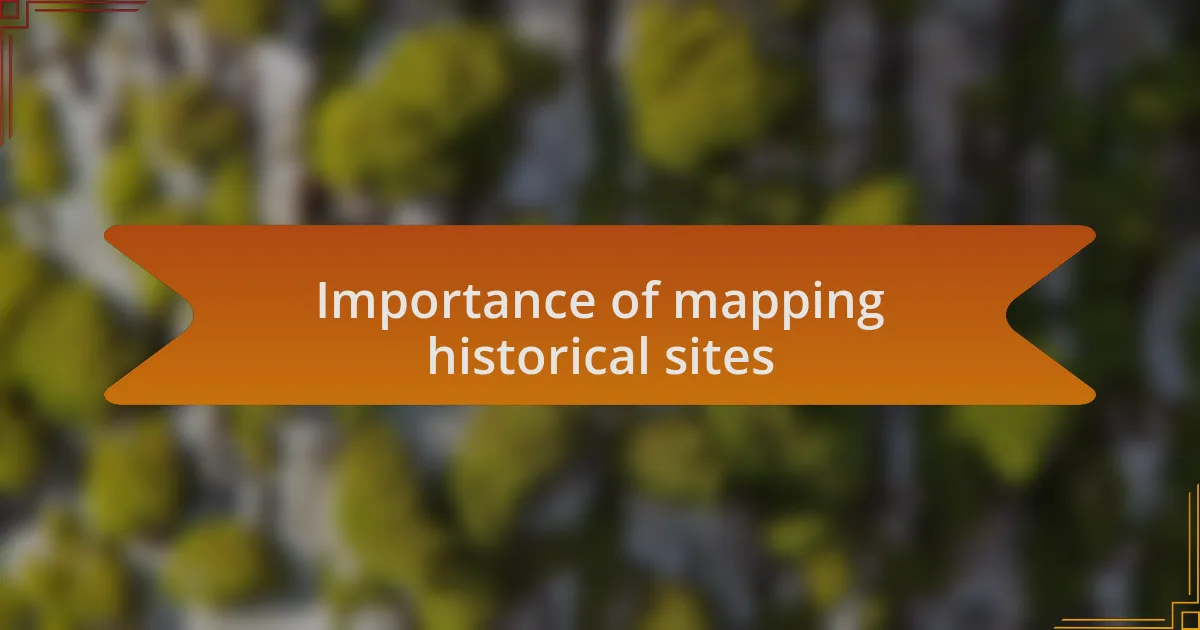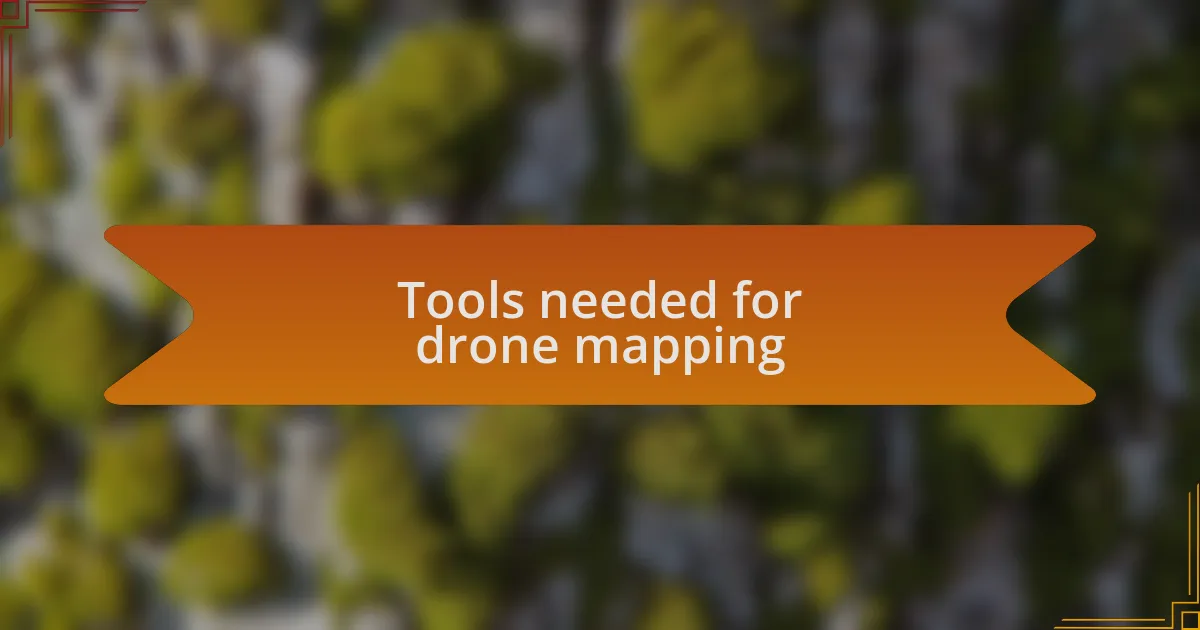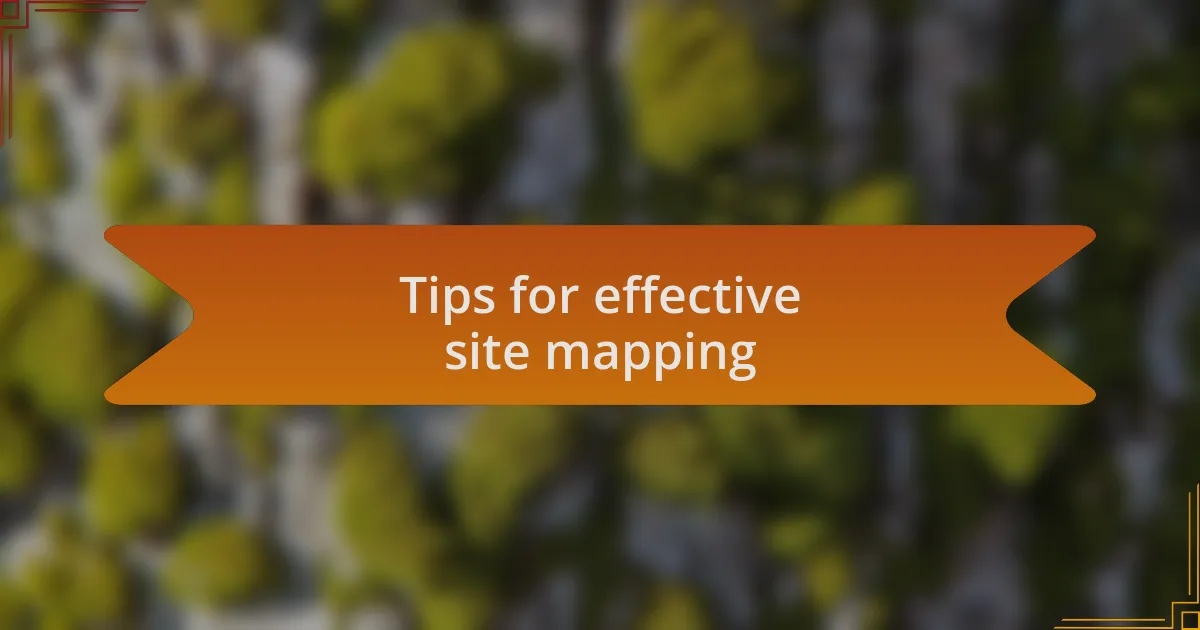Key takeaways:
- Drone mapping technology enhances data collection and visualization of historical sites, revealing hidden patterns and insights.
- Mapping historical sites is vital for cultural preservation and aids researchers in uncovering new findings.
- Technical challenges such as weather conditions and regulatory permissions can impact drone mapping efforts.
- Effective planning, timing, and community engagement are crucial for successful and meaningful site mapping projects.

Understanding drone mapping technology
Drone mapping technology has transformed how we collect and analyze data about our environment, particularly historical sites. I recall my first encounter with a drone during a mapping project in Zanzibar; I was amazed at how it effortlessly captured intricate details from above that would typically be missed on the ground. Have you ever wondered how such high-resolution images can tell stories about places that have stood the test of time?
At its core, drone mapping involves the use of unmanned aerial vehicles equipped with cameras and sensors to gather geospatial data. This data is then processed to create detailed maps, 3D models, and even orthomosaics – which are seamless images formed by stitching together thousands of smaller images. In my experience, I found that seeing these maps come together in real-time was nothing short of exhilarating, as it revealed insights that I could have never anticipated.
One of the most exciting aspects of drone mapping is its ability to provide a new perspective on historical sites, revealing patterns and features invisible from the ground. I often think about how this technology could potentially uncover forgotten stories of our past. Isn’t it exciting to think that, with every flight, we might be bringing history back to life in ways that were once unimaginable?

Importance of mapping historical sites
Mapping historical sites is crucial for preserving our cultural heritage and ensuring that future generations can connect with their past. I remember standing amidst the ruins of an old palace, feeling a deep sense of connection as I looked over the drone’s live feed displaying the site in its entirety. Have you ever felt that joy of discovery when uncovering layers of history right beneath your feet?
Moreover, these meticulous mappings serve as a vital resource for researchers and historians. During one such project, I worked alongside an archaeologist who used the drone imagery to chart previously undocumented structures, igniting a new research avenue. It made me realize how drone mapping not only breathes life into abandoned places but also opens up new conversations about who we are and where we come from.
The environmental impact of mapping can’t be overlooked either. By opting for drones, we minimize our footprint, allowing us to explore without disturbing the delicate ecosystems surrounding these historical sites. It’s rewarding to think that, as we gather data, we’re contributing to both historical knowledge and environmental conservation—two worthy causes that support each other. Doesn’t it feel powerful to know that technology like this can harmonize progress with preservation?
Overview of Zanzibar’s historical sites
Zanzibar, an archipelago steeped in history, is home to a treasure trove of historical sites that reflect its unique cultural tapestry. From the iconic stone buildings of Stone Town, a UNESCO World Heritage Site, to the lush ruins of ancient spice plantations, each location tells a story of trade, conquest, and resilience. I often find myself wandering these sites, feeling the whispers of the past as I trace my fingers along the timeworn walls.
One remarkable site is the Old Fort of Zanzibar, where the echoes of battles fought long ago still linger in the air. As I explored its rugged stones and expansive courtyards, I couldn’t help but think about the generations that have stood in that same spot, perhaps dreaming of freedom or a brighter future. It’s fascinating how these spaces connect us to our shared human experience, isn’t it?
The Palace Museum, once the home of sultans, showcases the opulent lifestyle enjoyed by Zanzibar’s rulers. Stepping inside, I was struck by the blend of Arab, Persian, Indian, and African influences that define the island’s cultural identity. It’s moments like these that make historical sites come alive for me, transforming mere structures into vibrant stories waiting to be discovered. Have you ever felt transported back in time as you stood in a place that holds so much meaning?

Tools needed for drone mapping
When it comes to drone mapping, the right tools make all the difference. I rely heavily on a high-quality drone equipped with a robust GPS and a high-resolution camera. These features allow me to capture intricate details of historical sites—every arch and stone is recorded with precision. Can you imagine trying to map the Old Fort without a drone? The aerial perspective reveals the vast expanse around it, something that ground-level views simply can’t provide.
Another essential tool is specialized mapping software. I use programs like Pix4D or DroneDeploy, which assist in processing the images and generating 2D maps and 3D models. This software not only streamlines the workflow but also enhances the accuracy of the final outputs. I remember the first time I processed a set of aerial images—seeing the layout I had captured come to life in a digital model was incredibly satisfying. Have you ever wished to see history unfold right before your eyes?
Don’t overlook the importance of batteries and storage solutions. Drone mapping can be power-intensive, especially when covering vast sites like the spice plantations. Having extra batteries on hand allows me to extend my exploration without interruption, capturing even the most remote corners. I often find myself racing against the sun, trying to get that perfect shot before twilight sets in. It’s a thrilling challenge that keeps me on my toes!

My first drone mapping experience
My first drone mapping experience was a blend of excitement and apprehension. I remember standing on the outskirts of Stone Town, the drone buzzing gently overhead while I focused intently on the screen. As I watched the live feed, I felt a rush of adrenaline—was I really about to capture images that would highlight the beauty of such a historically rich area?
Once I started flying, the landscape unfolded beneath me, and the realization hit: this was no ordinary photography. I could see the intricate details of the architecture and the layout of the streets, each telling a story from a bird’s-eye view. I couldn’t help but wonder—you know, when you see things from above, do those stories resonate differently? There was a moment, particularly when I flew over the old slave market site, that the gravity of history struck me deeply. It was as if the past was whispering through the camera, urging me to preserve its memory.
Retrieving my first set of images brought a wave of fulfillment, but it also came with a side of nerves. I hadn’t just captured data; I had documented a part of Zanzibar’s legacy. As I examined the photos, I felt a sense of responsibility, realizing that every click was a chance to share these stories. Have you ever felt that weight when undertaking a project as significant as this? It was humbling and exhilarating all at once.

Challenges faced during mapping
One significant challenge I encountered during mapping was the unpredictable weather in Zanzibar. On days when I was eager to fly, sudden showers or high winds would disrupt everything. I vividly recall one morning when I set up, only to watch storm clouds roll in, forcing me to delay the flight. How disappointing it was to feel ready, yet grounded by nature!
Another obstacle came from navigating the permissions and regulations for drone use in historical areas. Securing the necessary approvals was like navigating a labyrinth. It required patience and persistence. I often found myself asking, why is this process so complicated? In retrospect, I understand the importance of protecting historical sites, but it was a hurdle that tested my resolve.
Lastly, I faced technical issues with the drone itself. During one session, the drone lost its GPS signal, causing it to drift unexpectedly. My heart raced as I struggled to regain control. It was a reminder of how reliant we are on technology, but also how crucial it is to remain calm in the face of unexpected challenges. Would I let setbacks deter me? Absolutely not—they were opportunities to learn and grow in my mapping journey.

Tips for effective site mapping
When it comes to effective site mapping, planning your flight path is essential. I learned this the hard way during one of my first mapping attempts. I had a vague idea of where I wanted to go, but without a structured plan, I wasted precious time and battery. A clear route not only maximizes your drone’s potential but also helps avoid those pesky no-fly zones. Have you ever felt the nerves kick in when you realize you’re veering off course? It’s a reminder of how critical preparation is.
Choosing the right time of day can make a significant difference in the quality of your mapping. I discovered that early mornings, when the sun is just rising, provided the best light. The play of shadows and soft illumination made the historical sites pop on my screen. I was captivated by the surprise of how different everything looked compared to shooting under harsh midday light. Have you considered how the time can impact your images?
Lastly, always factor in the community around the historic site. Engaging with locals can unlock rich stories and insights about the area. I once spent an afternoon chatting with an elder whose family had lived there for generations. This not only enriched my understanding but also helped me capture locations that truly resonated with the site’s history. How often do we overlook the human element in mapping? Prioritizing these connections can elevate your project beyond mere images.